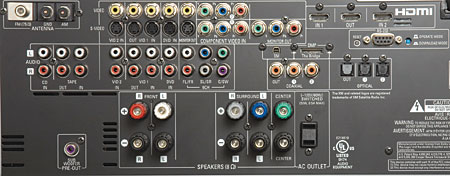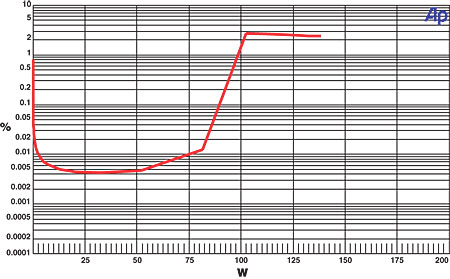Three Ways to Fill a Rack HT Labs Measures: Harman Kardon

All five channels driven continuously into 8-ohm loads:
0.1 percent distortion at 66.7 watts
1 percent distortion at 78.3 watts
Analog frequency response in Stereo Tone Out mode:
–0.32 dB at 10 Hz; –0.12 dB at 20 Hz
–0.29 dB at 20 kHz; –55.48 dB at 50 kHz
Analog frequency response with signal processing:
–0.31 dB at 10 Hz; –0.12 dB at 20 Hz
–0.28 dB at 20 kHz; –55.55 dB at 50 kHz

This graph shows that the AVR 147's left channel, from CD input to speaker output with two channels driving 8-ohm loads, reaches 0.1 percent distortion at 89.5 watts and 1 percent distortion at 98.5 watts. Into 4 ohms, the amplifier reaches 0.1 percent distortion at 112.2 watts and 1 percent distortion at 126.8 watts.
Response from the multichannel input to the speaker output measures –0.14 dB at 10 Hz, –0.04 dB at 20 Hz, –0.06 dB at 20 kHz, and –0.35 dB at 50 kHz. THD+N from the CD input to the speaker output was less than 0.058 percent at 1 kHz when driving 2.83 volts into an 8-ohm load. Crosstalk at 1 kHz driving 2.83 volts into an 8-ohm load was –75.87 dB left to right and –75.72 dB right to left. The signal-to-noise ratio with 2.83 volts driving an 8-ohm load from 10 Hz to 24 kHz with "A" weighting was –84.78 dBrA.
From the Dolby Digital input to the loudspeaker output, the left channel measures –0.07 dB at 20 Hz and –0.27 dB at 20 kHz. The center channel measures –0.07 dB at 20 Hz and –0.27 dB at 20 kHz, and the left surround channel measures –0.07 dB at 20 Hz and –0.31 dB at 20 kHz. From the Dolby Digital input to the line-level output, the LFE channel is +0.12 dB at 20 Hz when referenced to the level at 40 Hz and reaches the upper 3-dB down point at 99 Hz and the upper 6-dB down point at 118 Hz.—MJP
























































